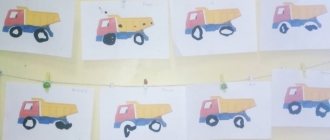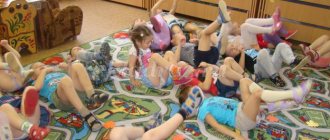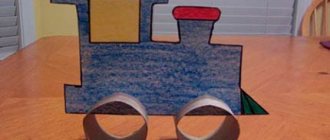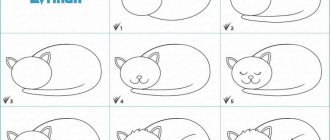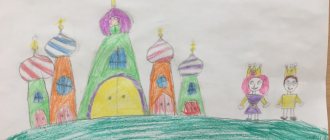My funny ringing ball
Educator:
Well done boys.
Playing with the ball is both fun and interesting. But even such games can cause trouble if you forget the safety rules. 1. Do not play with the ball near glass windows or shop windows. Why? (The ball can break them). 2. Do not play with the ball near the roadway. Why? (The ball can roll out under the wheels of a passing car and cause an accident). 3. And of course, under no circumstances should you run out onto the road for the ball! Why? (The driver may not have time to stop) Educator:
Well done! Now we're going to play a game
"Find a toy"
.
Children sit around a hoop and take turns putting their hand into a bowl of cereal, groping for a toy, calling it and showing it to other children (Doll, ball, car, cup, plate) Educator:
Guys, in one word we will call all those objects that you found ?
(children's answers - toys). Educator:
Yes, toys. And our ball is also a toy.
Independent activities of children:
Educator
: Well done!
Guys, today we will draw a beautiful round ball. For this we need these materials - what do you think they are? (shows semolina)
Touch it, what is it like? (crumbly, multi-colored, small, free-flowing). This is semolina. Semolina porridge is made from it. We will draw a ball using semolina. Take the brush in your right hand, with three fingers, just above the iron tip. Carefully dip the brush into the glue and use the brush to apply glue all over the ball. Now take a pinch of semolina and sprinkle it on the surface of the ball. Carefully pour excess semolina onto a tray.
You guys are great, everything worked out great for us.
Psycho-gymnastics
“
Call kindly” for example: BALL - BALL!
Children stand in a circle. The teacher invites the child to pass the ball (or toy) to the child standing next to him, affectionately calling him by name. The child takes the ball and passes it to the next child with the same task. After this, the children share their impressions and feelings.
Educator
: Well done boys! The ball really liked us and a smile appeared on his face. Everyone drew very well, actively participated, and played with the ball. And he tells us Thank you! And we will hang our balls on the stand and the guests who come to our group will admire them. And that’s not all…..The ball brought us treats (they give each child candy), let’s say a big thank you to him.
And now we will smile, we will hold hands together, and each other, goodbye, we will give a wish - seek knowledge, then you will always become smart!
Let's say GOODBYE to our guests!
Lesson summary:
What toy were we talking about today? What shape does the ball have? Where can you not play with the ball?
Notes on drawing in the second junior group “My funny ringing ball.”
Summary of GCD for drawing in the second junior group
"My funny ringing ball."
Goal: to develop in children the ability to draw round objects with a continuous, continuous movement of the brush.
Tasks:
Educational: learn to close a line into a ring.
Developmental: develop aesthetic taste, the ability to navigate on a sheet of paper; develop fine motor skills and logical thinking.
Educational: to cultivate interest in drawing, to be careful with toys.
Materials and equipment: box, balls of different sizes and colors (balls according to the number of children in the group, basket with toys, easel, sheets of paper, gouache of different colors (like the colors of the balls, brushes, glasses of water, napkins)
.
Contents of organized children's activities
1. Organizational moment.
Educator. - Guys, look, guests have come to us. Let's say hello to them.
Children. - Hello!
Educator: - Well done guys, now sit down on the chairs
Educator. This morning at the door of our group
I found a large box
(The teacher puts the box on the table)
. I really want to know what lies there. What about you guys? To find out what is in the box, we must solve the riddle:
I can jump and roll,
And if they leave me, I’ll fly.
Laughing faces all around
Everyone is happy about the round... (Ball)
Educator. Well done guys, you solved the riddle. (The teacher opens the box and takes out the ball)
. But there is not only a ball, but also a surprise that you will find out at the end of the lesson. Therefore, you should try to complete tasks and actively answer questions.
What shape does the ball have? (Children's answers: round)
.
What size are the balls? (Children's answers: big and small)
What color are the balls? (Children's answers: red, green, blue)
2. Familiarity with the shape of the object.
Educator. The ball can also be made of plastic, which is hard, or rubber, which is soft. Can jump, jump, roll. But it must have a round shape. But here we have a basket of toys. All the toys were mixed up in it. Help me arrange the toys and take away the balls for yourself. (Each child receives a ball)
. Why do we need so many balls? What are we going to do with them? Let's remember how to play with the ball.
3. Exercises with the ball.
a) “Ball up, down”
- the initial position of the child is standing, legs slightly spread, holding a ball in his hands, lifts it up and then lowers it down.
b) “Ball forward, backward”
- the initial position of the child is standing, with his legs slightly spread, holding a ball in his hands, stretching it forward, and then pulling him towards himself.
c) “Ball in the basket”
— Children stand at the table and throw the ball into the basket.
4. Drawing “My funny, ringing ball”
.
Educator: What a wonderful toy! How interesting and fun it is to play with her! Look what beautiful balls we have - red, blue, yellow. But before starting any work, you need to prepare the tool. To draw, we need a landscape sheet, a brush, a glass of water, gouache of different colors, and napkins. But in order to draw beautifully, you need to hold the brush correctly in your hand, so that it is comfortable for both you and your assistant - the brush, with three fingers. And now we must first moisten this brush in water, remove excess water on the edge of the jar. Then you need to put a little paint on the brush, and also remove the excess on the edge of the jar. Now I can draw my ball, with smooth, continuous movements without lifting my brush, we draw a round ball.
The teacher on the easel shows techniques for drawing the shape of a ball.
Children draw pictures. The teacher controls the work methods and provides assistance to children experiencing difficulties.
Conclusion:
Educator: Well done, guys! Everyone drew very well, actively participated, and played with me. Thanks everyone! And we will hang your balls on the stand, and the guests who come to our group will admire them. Now let’s remember what we did in class; a surprise awaits you for the correct answers.
Reflection:
Educator: What did we learn to draw? (Children's answers: ball)
What shape does the ball have? (Children's answers: round)
What size are the balls? (Children's answers: big and small)
What color are the balls? (Children's answers: red, green, blue, yellow)
Tell me, who has the most beautiful ball? (Children's answers: children choose)
.
Our lesson has come to an end. Thank you for your attention.
On the topic: methodological developments, presentations and notes
Abstract of an integrated GCD on non-traditional drawing techniques. Middle group. Topic: “My funny ringing ball” Educational area - artistic creativity Goal: to teach children rice.
“My cheerful ringing ball” based on the poem by S.Ya. Marshak (team work).
- Consolidate knowledge of A. Barto’s poem “Ball”; - Learn to pronounce together the words of the game “My cheerful, ringing ball”; - Continue learning to paint over the outline of a drawing using a piece of foam sponge;-.
Goal: - To consolidate knowledge of A. Barto’s poem “Ball”; - To learn to pronounce together the words of the game “My cheerful, ringing ball”; - To continue to learn how to paint over the outline of a drawing with help.
Summary of a lesson on non-traditional drawing techniques in the second junior group Topic: “My funny ringing ball” Purpose: To introduce children to a new technique of non-traditional drawing techniques.
Source

